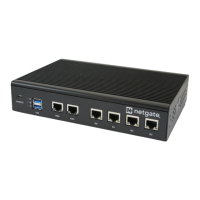Product Manual, TNSR 19.02
8. Choose an Instance Type, then click Next
Note: The available instance types are those that support ENA network adapters. These include all C5 and M5
instance types. The type of C5 or M5 instance depends on the needs of a given network. For networks with a
large number of subnets in the VPC or for networks that expect high throughput, one of the larger instance types
is likely to be more appropriate.
For information on bandwidth limits and limits on the number of Network Interfaces and IP addresses for
different instance types, see the following links:
• https://aws.amazon.com/ec2/instance-types/
• https://docs.aws.amazon.com/AWSEC2/latest/UserGuide/using-eni.html#AvailableIpPerENI
In environments where the requirements are unclear, start with c5.xlarge and migrate to a different instance type
later as necessary.
9. Configure Instance Details:
• Select the VPC in which to launch the instance
• Under Network Interfaces:
– Select the Management subnet as the subnet for the eth0 interface
– Click the Add Device button
– Select the WAN subnet as the subnet for the eth1 interface
Only two Network Interfaces may be added to an instance at launch time. The LAN interface can be added after
the instance is launched.
Click Next after completing the choices
10. Add storage if this instance will require more than the default 10GB disk, then click Next
11. Add Tags to identify this instance if desired, then click Next
12. Configure Security Group
Default rules should appear to allow SSH and ICMP. These rules can be used to create a new security
group, and to add access for other ports if needed.
Warning: The best practice is to limit the allowed Source to a specific address or network that will
be used connect to the TNSR instance.
Give the security group a name such as “TNSR management”.
13. Verify the settings selected in earlier steps, then click Launch
Select an ssh key or create a new key in the popup. Click Launch Instances
1.2. Cloud Platforms 41

